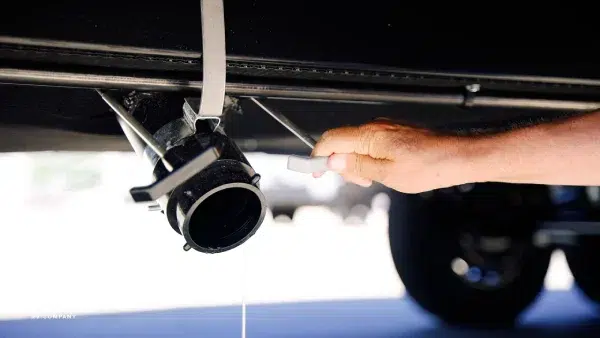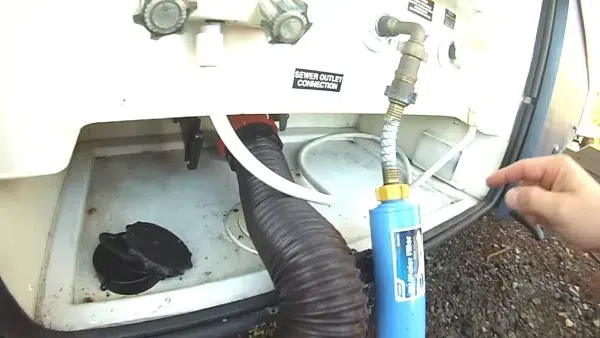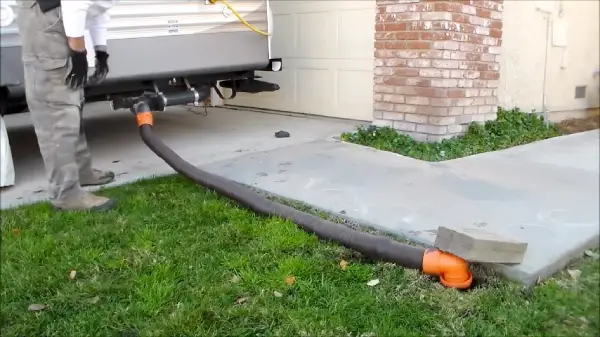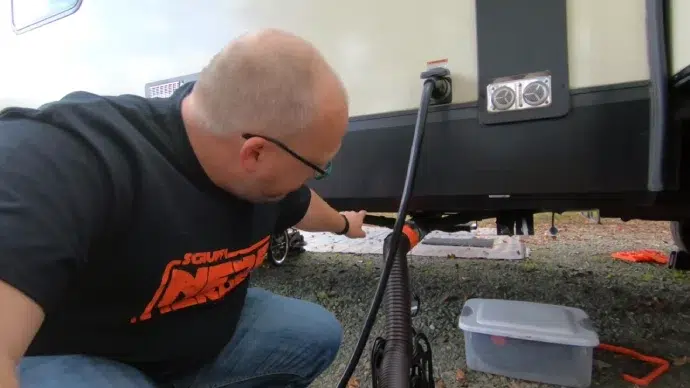Last Updated on May 29, 2023
Are you an avid RV traveler looking to hit the open road for a new adventure? Part of being a responsible RV owner understands the ins and outs of your vehicle’s holding tanks, particularly the black water tank.
One common question among new and seasoned RVers alike is how long black water can stay in the RV tank. It is estimated that black water can stay in an RV tank for up to ten days based on information on RV experts’ websites and forums.
This article will explore everything you need to know about black water tanks, including the factors that can affect their lifespan. So let’s dive into the murky waters of black water tank maintenance.
How Long Can Black Water Stay in RV Tank: What Affects?

Several factors can affect how long black water can stay in an RV tank. These factors include the size of the tank, ambient temperature, humidity levels, and tank maintenance.
No 01: Tank Size
The size of an RV tank is one of the most critical factors determining how long black water can stay in it. The larger the tank, the longer it will take to fill up and require dumping. On the other hand, smaller tanks will require more frequent dumping.
RV tanks come in different sizes, ranging from as small as 10 gallons to as large as 50 gallons or more. An RV tank’s size depends on the RV’s type and size. For instance, a Class A motorhome typically has a larger black water tank compared to a Class B or C motorhome.
RV owners need to know the size of their black water tank so they can plan accordingly and avoid overfilling it. Overfilling can lead to messy and unpleasant situations such as sewage backup, which is unpleasant and hazardous to health and the environment.
In addition to knowing the size of their tanks, RV owners should also keep track of their usage and estimate how long they can go before dumping their black water tanks. This estimation will depend on several factors, such as the number of people using the toilet, frequency of use, and duration of trips.
No 02: Ambient Temperature
Several factors, including ambient temperature, can affect how much black water stays in an RV tank. This refers to the surrounding air temperature where the RV is parked or stored.
High ambient temperatures can cause black water to decompose faster during hot weather, leading to odors and other problems. On the other hand, during cold weather, low temperatures cause black water to freeze inside the tank and pipes, making it difficult to drain.
Ideally, RV owners should aim for moderate ambient temperatures between 50°F and 80°F to minimize these issues. If you plan on storing your RV during extreme temperatures, taking extra precautions, such as adding antifreeze or using insulated tanks, is important.
No 03: Humidity Levels
The humidity levels can significantly affect how long black water stays in an RV tank. High humidity levels can cause the waste to break down more slowly, leading to a buildup of solids and an increase in the foul odor inside the RV.
Conversely, low humidity levels can lead to faster liquid waste evaporation, leaving more solids that may clog the tank’s sensors and valves.
Monitoring and regulating the moisture levels inside the RV is recommended to mitigate the effects of humidity on black water. Dehumidifiers or opening windows and vents can help reduce humidity levels and promote better airflow, which aids in the waste breakdown.
No 04: Tank Maintenance
Proper maintenance of the black water tank is crucial in ensuring that it functions efficiently and for an extended period. Neglecting the tank can lead to a waste buildup, which can cause blockages and unpleasant odors. To prevent these problems, it is essential to maintain the tank regularly.
One way to maintain the black water tank is by using digestive treatments that help break down the solid waste and toilet paper. These treatments contain beneficial bacteria that digest waste and eliminate odors. They are available in liquid or powder form and are added directly to the tank through the toilet.
Another way is by flushing it regularly with clean water. Flushing helps remove any leftover waste particles that may have stuck on the tank’s walls, preventing them from accumulating over time. It also helps keep the sensors clean, providing accurate tank-level readings.
It is also important to regularly monitor the waste level in the black water tank. This will help you know when it’s time to dump it before it reaches full capacity. Overfilling can cause leaks or blockages, leading to costly repairs.
How do you store your RV’s black water tank?

After dumping your black tank, always rinse and flush it for about 20 to 30 minutes to eliminate any remaining waste and debris. This procedure helps prevent clogs and ensures your tank is always clean and fresh.
When storing your black and grey water tanks, ensure they are clean and empty before storing them. Add clean water and a bacterial tank treatment to promote the growth of beneficial bacteria that break down organic waste and prevent odor build-up.
Also, make sure that the weather is appropriate for storage. You can store your tanks without worry when there is no risk of freezing or below-freezing temperatures.
What’s the frequency of emptying the black tank in your Class B RV?
Frequent and regular emptying is necessary to properly maintain your RV’s black water tank and prevent unpleasant smells.
It would be best to aim to empty your holding tanks every 3 to 5 days or when they reach two-thirds to three-quarters full. Pay attention to the tank’s level and empty it accordingly to avoid overflows or backups.
Emptying the black water tank also involves cleaning and sanitizing it after each dump. Using appropriate cleaners and disinfectants helps to keep the tank’s interior clean and odor-free.
What are the signs that black water needs to be dumped from the RV tank?
Several signs indicate that black water must be dumped from the RV tank. The first and most obvious sign is a foul odor inside the RV. This odor can be caused by gases released by the decomposing waste in the tank. If you notice a strong smell coming from your RV, it’s time to dump the black water.
Another sign is if your black water drains slowly in a slow-draining toilet or sink. This can indicate too much waste in the tank, causing blockages in your plumbing system. If you notice this problem, it’s best to dump your black water as soon as possible.
A visual inspection of your RV tank can also help you determine if it’s time to dump your black water. Most modern RVs have sensors that show how full each tank is, but these sensors are not always accurate. You can also check for signs of overflow or leakage around the tank area.
Regular cleaning and flushing of the tank are essential to avoid these signs and extend the time before dumping black water from an RV tank. Using chemical treatments can also help break down waste and reduce odors.
It’s important to properly dispose of black water from an RV tank to avoid health and environmental hazards associated with improper disposal. Dumping black water on public lands or bodies of water is illegal and poses serious risks to both humans and wildlife.
Is there a way to extend the time before dumping RV black water?
One way to extend the time before you dump black water is by using chemical treatments. These treatments are designed to break down waste and reduce odors in the tank.
Many different types of chemical treatments are available on the market, ranging from biodegradable options to those containing harsh chemicals. Choosing a safe treatment for your RV and the environment is essential.
Another way to extend the time between dumping black water is by regularly cleaning and flushing the tank. This includes using a high-pressure hose or wand to clean out any remaining waste after dumping. It’s also essential to ensure all waste has been flushed out of the system before adding new chemicals or water.
By combining these methods, RV owners can significantly extend the time between dumping their black water tanks. But, it’s important not to wait too long between dumps as this can lead to foul odors inside the RV and slow-draining toilets or sinks.
What are the safe and legal methods for dumping black water?

Following safe and legal methods to avoid health and environmental hazards is essential when emptying an RV tank. Black water contains human waste and can carry harmful bacteria and pathogens that can cause illness if improperly disposed of.
One safe and legal method for dumping black water is to use designated dump stations. Many campgrounds, RV parks, and rest areas have dump stations. These stations typically have a sewer inlet for the RV’s discharge hose and a nearby water source to rinse the tank.
Another option is to use portable waste tanks that can be emptied at a designated dump station. Portable waste tanks are especially useful for RVers who plan to stay in one location for an extended period of time or who are camping in areas without access to dump stations.
It is important to note that dumping black water onto the ground or into bodies of water is illegal and can result in fines or other penalties. Also, dumping black water improperly can harm the environment by contaminating soil and water sources.
Protect Your RV and the Environment with Proper Black Water Management
If you’re setting out on a camping trip in your RV, understanding black water and how to manage it is crucial for a successful, stress-free experience.
Neglecting the signs that your black water tank needs to be emptied can have serious consequences, making regular cleaning and chemical treatments vital to extend the interval between necessary dumps.
Also, proper disposal of black water is more than just good practice. It’s integral to protecting the environment and public health from hazardous waste.
With these considerations in mind, you can confidently embark on your next RV adventure, knowing you’ve taken the necessary steps to protect yourself and your surroundings.



